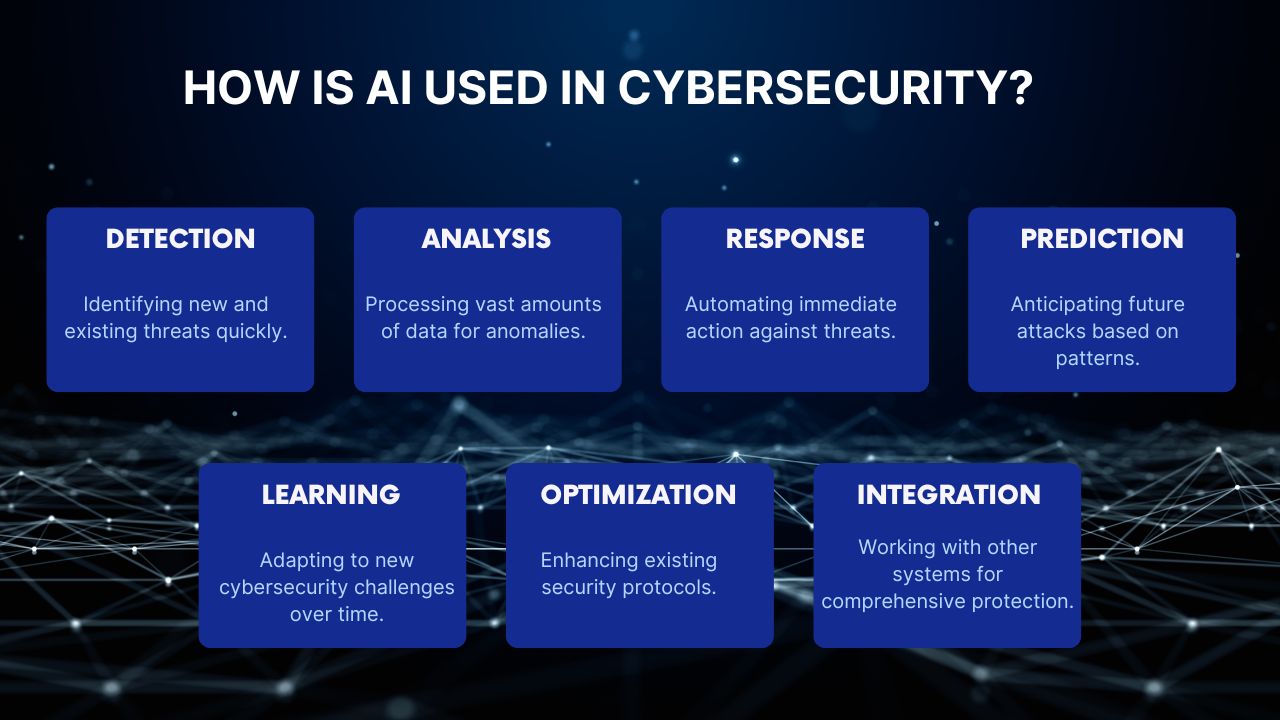Cybersecurity is being completely revolutionised by artificial intelligence (AI) and machine learning (ML). Security systems can now function outside of traditional rule-based strategies, which improves their capacity to identify and neutralise sophisticated cyberattacks. Massive datasets can be instantly scanned by artificial intelligence (AI) for patterns and anomalies that might point to security vulnerabilities.
Machine learning algorithms can adapt to changing cyberthreats thanks to continuous learning, which makes it possible to put preventive security measures in place. Cybersecurity frameworks gradually incorporate new security risks to strengthen digital ecosystems against them. Additionally, this enhances incident response, fortifies defences against a constantly changing landscape of cyberattacks, and speeds up threat detection.
What is AI/ML?
The tremendous advances in computer science and data processing, such as machine learning and artificial intelligence are causing rapid changes in many industries.
It is getting harder to gather, process, and analyse the growing volume of important data for other companies and organisations going through a digital transformation. There are new methods and tools available to control the volume of data gathered, look for patterns, and act upon those patterns when they are discovered.

Massive data sets and sophisticated processing algorithms combine to create artificial intelligence. As networks and systems proliferate, artificial intelligence (AI) assists in automating cybersecurity services and processes massive volumes of data far faster than a human could.
Network Security
By utilising network traffic data, artificial intelligence (AI) systems can identify patterns and anomalies that may indicate an impending intrusion or attack. Artificial Intelligence (AI) can recognise potential threats in any deviation from the norm by analysing cybersecurity network security traffic patterns.
Threat Detection
Artificial intelligence results from complex processing algorithms and massive data sets. Artificial intelligence (AI) processes enormous volumes of data far more quickly than a human could and helps automate cybersecurity procedures as networks and systems become more prevalent.
Behavioural Analysis
To find patterns that could point to malicious activity or unauthorised access, AI can use machine learning to analyse user behaviour. The efficacy of threat identification and user behaviour monitoring increases, and false positives decrease.
How Machine Learning is used in Cybersecurity
Artificial intelligence's machine learning field creates algorithms that predict computer behaviour using statistical analysis and pre-existing datasets. Subsequently, the computer can change its ongoing task and potentially execute operations for which it was not intended. Machine learning cybersecurity has become an essential cybersecurity technology due to these benefits.
Early Detection of Potential Threats
Due to its ability to sift through millions of files and identify those that may be dangerous, machine learning is increasingly used to detect threats and remove them before they can cause havoc.
Identify Network Vulnerabilities
To be more proactive, businesses are using machine learning instead of waiting for cyberattacks to happen. Penetration testing involves simulating a cyberattack to find vulnerabilities in a company's networks, firewalls, and systems. Software patches, code fixes, and other fixes can be applied using machine learning to close any security gaps in an organisation.
Minimising it and the Workload
Conducting penetration tests, distributing security updates, and keeping an eye on devices all require time and work. However, because machine learning can automate these more routine and repetitive tasks, IT teams no longer have to worry about performing them. This frees up IT experts to concentrate on more crucial security-related problems.
Benefits of AI/ML in Cybersecurity Strategy
Artificial intelligence and machine learning tools can bolster your organisation's cyber posture and support the work of the present teams.
Artificial intelligence (AI) tools, which operate faster and more accurately than human teams, can identify cybersecurity threats and vulnerabilities more quickly and accurately.
Additionally, these tools have faster data processing speeds, which provides teams with more information to work with when developing plans and addressing threats.
Not only does this help with planning, risk reduction, and trend identification, but it also saves money because operations happen faster and require less human involvement.
Role of Machine Learning and AI in Threat Hunting
Threat hunting benefits immensely from machine learning (ML), which makes it easier and better to analyse large volumes of data that are difficult to diagnose with traditional techniques. Security teams can step in before any harm is done because they are skilled at spotting patterns and anomalies that might indicate a possible threat.
Artificial intelligence is essential to threat hunting since it offers up-to-date information on potential threats and automates the analysis of various data sets. Threat hunting cybersecurity may become more successful and efficient due to artificial intelligence's (AI) ability to handle unstructured data and draw connections that people might overlook.
Using Artificial Intelligence and Machine Learning Together in Threat Hunting
A threat-hunting method that works well can be created by combining ML and AI. While artificial intelligence cybersecurity can analyse this data in real-time and provide insightful analysis, large-scale data sets can be used to train machine learning (ML) algorithms to identify patterns and anomalies. This combination lowers the possibility of a successful cyberattack by enabling security teams to swiftly and accurately identify threats.
Future Impact of AI and ML on Cybersecurity
AI and ML will significantly impact cybersecurity as they develop. A few possible future effects of AI and cybersecurity and machine learning will be covered in this section.
- Improved Threat Detection
One of the most significant advantages of AI machine learning in cybersecurity is their much faster threat detection than human intelligence. With advanced algorithms and machine learning, artificial intelligence (AI) systems can analyse massive amounts of data in real time and identify anomalies and potential threats. The significant improvement in response times and threat detection will make it more difficult for cybercriminals to launch attacks. - Improved Cybersecurity Training
AI and ML can improve cybersecurity training by mimicking cyber threats and offering each student a personalised learning experience. Consequently, cybersecurity experts will gain additional knowledge and expertise, enabling them to address novel and developing cyber threats better. - Autonomous Security Systems
AI and ML-driven autonomous security systems may become commonplace shortly. The capacity of these systems to decide and act without human input will significantly speed up response times and might even stop cyberattacks before they start.
Integration of Machine Learning and AI in Cybersecurity Services
- Through the automation of formerly manual tasks, machine learning and ai cybersecurity hold the potential to improve cybersecurity process efficiency significantly.
- Although artificial intelligence (AI) and machine learning (ML) can analyse enormous volumes of data in real time, they can quickly identify potential threats and anomalies and enable proactive responses.
- For organisations, the cost of cybersecurity is a persistent challenge. Using fewer human resources allows businesses to cut costs by using AI and machine learning to identify threats early and prevent significant harm from happening.
Other Blogs

From Nuclear Centrifuges To Machine Shops: Securing IoT
IoT or ‘the internet of things’ has been around for a lot longer than the buzzword
Read More


Demystifying XDR
As the capabilities of threat actors have increased so have the tools which we utilize to detect and respond to their activities.
Read More


Cybersecurity In A Post Pandemic World
As many cyber security practitioners will tell you, the most imminent and dangerous threat to any network are the employees accessing it.
Read More


